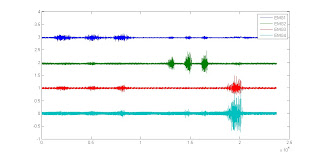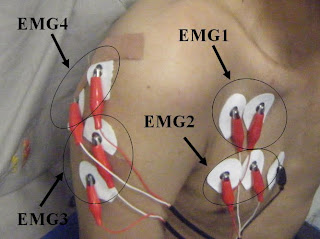Monday, November 29, 2010
Monday, June 28, 2010
Wireless EMG
Main of EMG is 100 - 300 Hz. so It have to use sampling rate 10 times of EMG is about 3000 Hz.
The past, I ever developed wireless EMG which used radio frequency. Graph is so complete more than now.
Wednesday, June 2, 2010
Tuesday, May 25, 2010
Wireless EMG 4 Channels
Monday, May 17, 2010
EMG (Ground Safe)
Thursday, May 6, 2010
Measure EMG By Micro-Controller
Tuesday, April 27, 2010
เทคนิค EMG
Saturday, April 17, 2010
มาดูการทดลองเรื่อง Filter ครับ
ใน ที่นี้จะเป็นการเปรียบเทียบระหว่างผลการ Simulation และ ผลการทดลองจริง โดยเปรียบเทียบทางด้าน Time Domain และ Frequency Domain จะเห็นว่าผลการ Simulation และผลการทดลองจริง มีแนวโน้มไปในทางเดียวกัน วงจรข้างต้นนั้นมี Cut-off Frequency = 100 Hz ใช้ Electronics Workbence ในการ Simulation และ เก็บข้อมูลการทดลองด้วย Aligent Oscilloscope DS3000
Monday, April 5, 2010
EMG Measurement 4 channels


จากคราวที่แล้วเป็นสัญญาณ EMG 4 channels ที่ผมได้ออกแบบไว้นะะครับ สำหรับตัวเครื่องนี้ เป็นดังรูปข้างบนนี้นะครับ เครื่องนี้ผมออกแบบให้กับทาง FIBO ใช้งบประมาณในการศึกษาและออกแบบประมาณ 40,000 บาท เมื่อเทียบกับที่ใช้กันตามโรงพยาบาลถือว่าถูกกว่าที่ใช้กันทั่วไปมาก ในที่นี้ผมใช้วงจรขยาย แบบ Instrument Amplifier (INA129) และ แยกกราวน์ ด้วย Isolation Amplifier ส่วนทางด้าน Software นั้นผมพัฒนาด้วย Labview โดยมี NI-USB6210 เป็นตัวแปลงสัญญาณ Analog to Digital
Sunday, April 4, 2010
EMG 4 Channels


จากรูปครับเป็นส่วนหนึ่งในงานวิจัยของผม ผมพยายามที่จะสร้างแขนเทียมสำหรับคนพิการเหนือข้อศอก(ต่ำกว่่าหัวไหล่) โดยใช้สัญญาณ EMG เป็นตัวควบคุม ผมได้พยายามที่จะออกแบบเครื่องวัดสัญญาณ EMG มาเป็นเวลานาน ซึ่งโดยแท้จริงแล้วในเรื่องของสัญญาณในระบบ Analog นั้น Active Filter, Passive Filter เป็นเรื่องเล็กน้อยมากเมื่อเทียบกับ Noise reduction เทคนิคอื่นๆ ยกตัวอย่างเช่น Balancing, Grounding, Shielding เป็นต้น ซึ่งเครื่องวัดสัญญาณที่ผมได้ออกแบบในเวอร์ชั่นนี้ถือว่าได้ผล เป็นที่น่าพอใจพอสมควร โดยสามารถลด effect ที่เกิดจากกราวน์ของทั้ง 4 channels ได้อย่างอิสระต่อกัน ในอนาคตผมจะพยามยามพัฒนาเครื่องวัดสัญญาณ EMG ให้มีคุณภาพดีเยี่ยมทัดเทียมกับเมืองนอก จากรูปผมได้จำลองตัวเองเป็นคนพิการ โดยวัดสํญญาณบริเวณหน้าอกและหัวไหล่ สัญญาณที่ออกมา ก็สามารถนำมาใช้งานต่อไปได้
EMG Sound Card
Tuesday, March 30, 2010
Electromyography (EMG): What Is It, and Does It Hurt?
Suspense can be valuable if you're Stephen King and writing horror fiction. Mr. King takes advantage of the fact that your own imagination can conjure up scarier things than he can put on the page. That's why he makes you wait page after page to discover what scary thing is around the next corner. When he finally tells you about the giant, blue monster, it's not nearly as bad as what you had already imagined. If his monster was scarier than what you could imagine, do you think he would have made you wait so long? Of course not! Mr. King is no dummy. Just look at his sales record.
But when it comes to medical tests, suspense is no good. You don't need to worry about the test you're going to have in addition to the medical problem that got your referred for it in the first place.
What about electromyography, also known as EMG? You should definitely not listen to what your brother-in-law has to say about it. If he had the test already, do you think he's going to make himself sound like: (1) the bravest guy in existence, or (2) a total wimp? Well, you know your brother-in-law better than I do, but my money is on number one.
So if you listen to your brother-in-law, he'll tell you what a terrible, awful, painful test it was, and how he was brave, valiant, and just about the most courageous guy who ever had it. So now he's got you quaking in your boots. Or at least worrying.
Relax. It's not that big a deal. Have you been to a dentist? Probably not as bad. Have you ever given blood? Probably not as bad. Have you ever had a baby? Definitely, nowhere near as bad! (I'm a male, but my wife assures me on this one.)
So let's get down to the particulars. An electromyography test involves needles. The needles do puncture the skin. Moreover, they enter muscle tissue. But the testing is done with just one needle at a time and just one muscle at a time. Although the needles used in this test are larger than those tiny, hair-like items used for acupuncture, they are much skinnier than those used for blood-drawing.
You do feel them when they are inserted, but the electromyographer (doctor doing the test) gives you advance warning in each case, and the doctor tries to get the maximum diagnostic information out of each needle-insertion while simultaneously minimizing the pain. The goal is to obtain information, not to hurt you.
Why would this be inflicted upon you in the first place? Usually it's because your own doctor thinks you might have a nerve or muscle condition and wants to narrow down the possibilities, seek confirmation, or eliminate a particular diagnosis.
Electromyography is a term meaning "electrical muscle recording." Because muscle is an electrical tissue, the needle electrode in the muscle, when connected to an amplifier and an oscilloscope screen, can show the muscle's electrical activity as a series of voltage-fluctuations. Moreover, the signal is also fed through a speaker, so you and the electromyographer can listen to what the muscle has to say. Each muscle is analyzed while you tense it, and again while you relax it.
Normal muscles display typical patterns to the eye and ear through the oscilloscope and speaker. Abnormal muscles show altered patterns. Sometimes the abnormality is more evident on the oscilloscope, and sometimes more evident on the speaker. Muscles that are themselves sick (myopathy) show one pattern, while muscles that are connected to sick nerves (neuropathy) or spinal roots (radiculopathy) can show yet another pattern.
Electromyography is often paired with nerve conduction studies performed at the same testing session by the same doctor and with the same equipment. Each test--EMG and nerve conduction studies--has its own story to tell, as well as its own strengths and weaknesses in its ability to show signs of disease. The results of the electromyography and nerve conduction studies are considered together to come up with a more complete, combined test-outcome and report.
The time required for testing can depend on the nature of the problem. Also, the electromyographer might add or subtract additional testing depending on how the initial components turn out. Overall, a typical session might last between 45 and 90 minutes. That doesn't mean that the patient is subjected to unpleasantries during that whole period of time. Actually, much of the time is devoted to getting all the little pieces and parts of equipment organized and in place for each "mini-test" comprising the overall testing session.
So when your doctor refers you for electromyography, don't listen to your brother-in-law. What does he know anyway? (Wait a minute, I'm somebody's brother-in-law, too! But you get the idea.) As an adventure, EMG is less than it's cracked up to be. As a diagnostic test, it can be very useful.
(C) 2005 by Gary Cordingley
Gary Cordingley is a clinical neurologist, teacher and researcher working in Athens, Ohio. For more health-related articles see his website at: http://www.cordingleyneurology.com
Article Source: http://EzineArticles.com/?expert=Gary_Cordingleyhttp://EzineArticles.com/?Electromyography-(EMG):-What-Is-It,-and-Does-It-Hurt?&id=41284



















